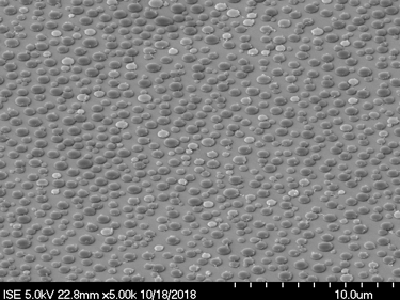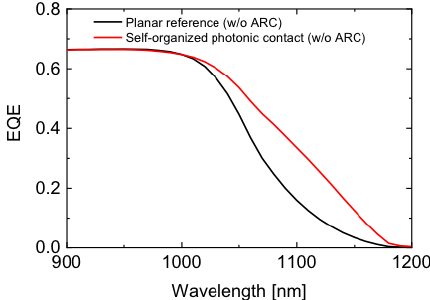Potential improvements for polymeric rear side light trapping structures in silicon-based tandem solar cells were investigated. The focus is on a drastic simplification for the realization of a photonic rear side contact.
We investigated a self-organization process leading to a pseudo-periodic structure with a well-defined and narrow size pitch distribution of polymeric features (self-organized photonic contact). This is based on the phase separation of two immiscible polymers in a solution that is spin coated. After the spin coating and the simultaneous phase separation, one polymer can selectively be removed and the structure is metallized. EQE measurements of solar cells with such structures showed that very similar results can be expected for this bottom-up process as for the structures realized via NIL that lead to recent efficiency records [1]. Thus, a photonic light trapping structure can be realized without applying any lithography.
This way we managed to realize a spherical polystyrene (PS) structure with a pseudo period of approx. 1 µm as targeted for. EQE measurements of solar cells with such polymeric rear side structures showed an integrated current gain, which is comparable to the one reached using NIL. More Details can be found in [2].
References
[1] R. Cariou, J. Benick, F. Feldmann, O. Höhn, H. Hauser, P. Beutel, N. Razek, M. Wimplinger, B. Bläsi, D. Lackner, M. Hermle, G. Siefer, S. W. Glunz, A. W. Bett, and F. Dimroth, “III–V-on-silicon solar cells reaching 33% photoconversion efficiency in two-terminal configuration,” Nature Energy, vol. 17, p. 183, 2018.
[2] H. Hauser, O. Höhn, R. Müller, N. Tucher, K. Mühlbach, R.M. da Silva Freitas, J. Benick, M. Hermle, B. Bläsi, “Polymer-Based Rear Side Light Trapping Structures for Silicon-Based Tandem Solar Cells”, Presented at the 36th EUPVSEC 2019

